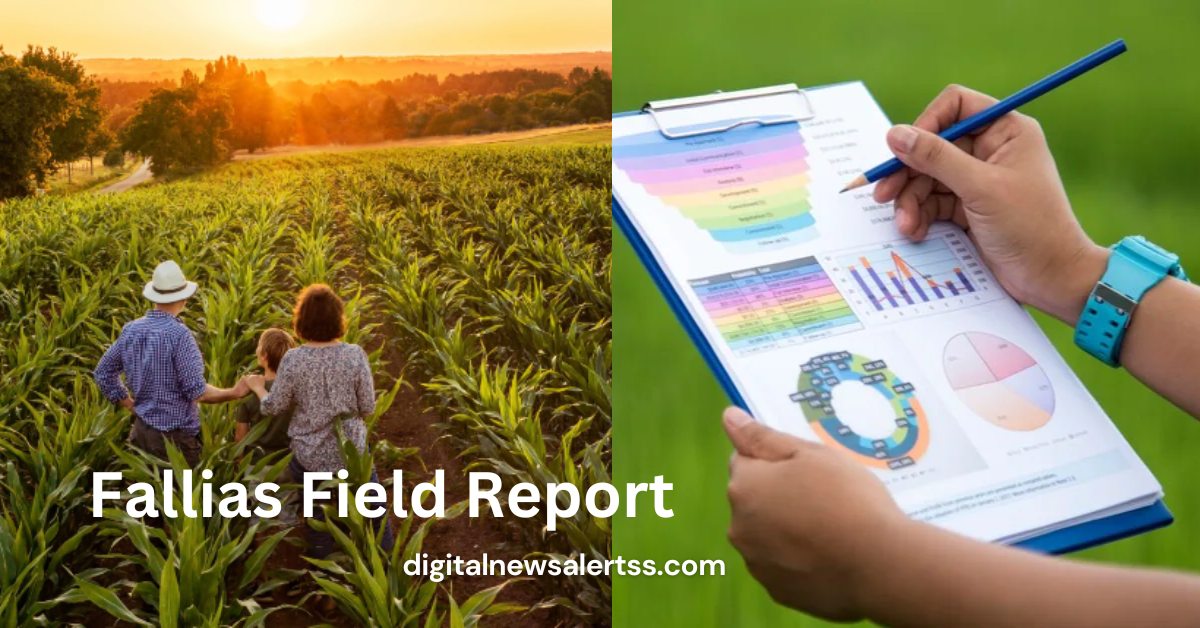In recent years, soil health has become a crucial topic in agriculture and environmental science. Among the many resources available, Fallias Field Report stands out as a comprehensive guide that delves deeply into the intricacies of soil health. This article will explore the various aspects of the “Fallias Field Report,” offering insights, analyses, and practical applications to help readers understand and implement better soil management practices. Whether you’re a farmer, gardener, or simply interested in sustainable agriculture, this guide will provide you with valuable information on soil health.
What is Fallias Field Report?
Fallias Field Report is a comprehensive document that focuses on the critical aspects of soil health. It is designed to help landowners, farmers, and agricultural professionals understand the importance of maintaining healthy soil, the factors that contribute to soil degradation, and the practices that can improve soil quality.
The Purpose of Fallias Field Report
The primary goal of Fallias Field Report is to promote sustainable agricultural practices by emphasizing the importance of soil health. Soil is not just a medium for plant growth; it is a living ecosystem that supports various forms of life. Healthy soil contributes to better crop yields, reduced need for chemical fertilizers, and a more sustainable environment.
Why Soil Health Matters
Soil health is essential for several reasons:
- Nutrient Cycling: Healthy soil provides the necessary nutrients for plant growth. When soil is degraded, it loses its ability to support plant life effectively.
- Water Retention: Good soil structure allows for better water retention, reducing the need for irrigation and helping plants survive during dry periods.
- Ecosystem Support: Soil supports various microorganisms, insects, and plants. Healthy soil contributes to a balanced ecosystem.
- Carbon Sequestration: Soil can store carbon, helping to reduce the amount of CO2 in the atmosphere and combat climate change.
Key Components of Fallias Field Report
Fallias Field Report is divided into several sections, each focusing on a different aspect of soil health. Below, we’ll explore the key components of the report.
1. Soil Composition and Structure
Understanding soil composition and structure is the first step in maintaining healthy soil. Soil is made up of minerals, organic matter, water, and air. The balance of these components determines the soil’s ability to support plant growth.
Minerals
Soil minerals are derived from weathered rocks and are essential for plant growth. They provide nutrients like nitrogen, phosphorus, and potassium, which are vital for plants.
Organic Matter
Organic matter consists of decomposed plant and animal material. It plays a crucial role in improving soil structure, retaining moisture, and providing nutrients to plants.
Water and Air
Water and air are essential for soil health. Good soil structure allows for proper water infiltration and air exchange, which are necessary for plant roots and microorganisms to thrive.
2. Soil pH and Nutrient Levels
Soil pH is a measure of the soil’s acidity or alkalinity. It affects the availability of nutrients to plants. Fallias Field Report emphasizes the importance of testing soil pH and adjusting it as needed to optimize nutrient availability.
Testing Soil pH
Soil pH can be tested using simple kits available at garden centers. The ideal pH range for most plants is between 6.0 and 7.5. If the pH is too low (acidic) or too high (alkaline), nutrients may become unavailable to plants.
Adjusting Soil pH
If the soil is too acidic, lime can be added to raise the pH. If the soil is too alkaline, sulfur or organic matter can be added to lower the pH. Fallias Field Report provides detailed guidelines on how to adjust soil pH based on test results.
3. Soil Erosion and Compaction
Soil erosion and compaction are significant threats to soil health. Fallias Field Report highlights the causes of these issues and offers solutions to mitigate them.
Causes of Soil Erosion
Soil erosion is caused by wind, water, and human activities. It leads to the loss of the topsoil, which is the most fertile layer. Preventing erosion is essential for maintaining soil health.
Preventing Soil Erosion
Fallias Field Report recommends several practices to prevent soil erosion:
- Cover Crops: Planting cover crops helps protect the soil from erosion by providing ground cover.
- Contour Plowing: Plowing along the contour of the land reduces water runoff and soil erosion.
- Terracing: Creating terraces on slopes helps slow down water flow and prevent erosion.
Soil Compaction
Soil compaction occurs when soil particles are pressed together, reducing pore space and limiting water infiltration and root growth. It is often caused by heavy machinery or repeated foot traffic.
Preventing Soil Compaction
To prevent soil compaction, Fallias Field Report suggests:
- Reducing Tillage: Minimizing tillage helps maintain soil structure and reduces compaction.
- Using Organic Matter: Adding organic matter improves soil structure and reduces compaction.
- Rotating Crops: Crop rotation helps prevent soil compaction by promoting diverse root systems.
4. Soil Microorganisms and Biodiversity
Soil is a living ecosystem that supports various microorganisms, including bacteria, fungi, and insects. These organisms play a vital role in maintaining soil health by decomposing organic matter, cycling nutrients, and improving soil structure.
The Role of Microorganisms
Microorganisms break down organic matter, releasing nutrients that plants can use. They also help improve soil structure by binding soil particles together.
Promoting Soil Biodiversity
To promote soil biodiversity, Fallias Field Report recommends:
- Reducing Chemical Use: Overuse of chemical fertilizers and pesticides can harm soil microorganisms. Using organic alternatives helps maintain soil biodiversity.
- Adding Organic Matter: Organic matter provides food for microorganisms, promoting a healthy soil ecosystem.
- Planting Diverse Crops: Growing a variety of crops supports different types of microorganisms, enhancing soil biodiversity.
5. Soil Testing and Monitoring
Regular soil testing and monitoring are essential for maintaining soil health. Fallias Field Report provides guidelines on how to test soil, interpret the results, and take action based on the findings.
Soil Testing Methods
Soil testing involves collecting soil samples and analyzing them for pH, nutrient levels, and other factors. Fallias Field Report recommends testing soil at least once a year.
Interpreting Soil Test Results
Soil test results provide valuable information about the soil’s condition. Based on the results, you can determine whether your soil needs amendments or adjustments to improve its health.
Monitoring Soil Health
In addition to testing, monitoring soil health involves observing changes in soil structure, moisture levels, and plant growth. Fallias Field Report emphasizes the importance of regular monitoring to detect and address issues early.
6. Sustainable Soil Management Practices
Sustainable soil management practices are essential for maintaining soil health over the long term. Fallias Field Report offers practical tips for implementing these practices on your farm or garden.
Crop Rotation
Crop rotation involves growing different crops in the same area in sequential seasons. This practice helps prevent soil depletion, reduces pest and disease pressure, and improves soil structure.
Cover Crops
Cover crops are plants grown primarily to protect and improve the soil. They help prevent erosion, add organic matter, and improve soil fertility.
Conservation Tillage
Conservation tillage involves minimizing soil disturbance during planting and cultivation. This practice helps maintain soil structure, reduce erosion, and promote soil health.
Organic Fertilizers
Organic fertilizers, such as compost and manure, provide essential nutrients to plants while improving soil structure and promoting biodiversity.
7. Case Studies and Success Stories
Fallias Field Report includes several case studies and success stories that demonstrate the effectiveness of sustainable soil management practices. These real-world examples provide valuable insights into how these practices can be applied in different settings.
Case Study: A Small-Scale Farm in the Midwest
One case study featured in Fallias Field Report involves a small-scale farm in the Midwest that implemented cover cropping and crop rotation. The farm saw significant improvements in soil health, including increased organic matter, reduced erosion, and better crop yields.
Case Study: An Urban Garden in California
Another case study focuses on an urban garden in California that used organic fertilizers and reduced tillage. The garden experienced improved soil structure, better water retention, and healthier plants.
Insights and Analysis
While Fallias Field Report provides a wealth of information on soil health, it’s essential to go beyond the basics and consider the broader implications of soil management practices. Here are some insights and analysis based on the report’s findings.
The Long-Term Impact of Soil Health on Agriculture
Soil health has long-term implications for agriculture. Healthy soil can sustain crop production for generations, while degraded soil leads to reduced yields and increased reliance on chemical inputs. Investing in soil health is not just about short-term gains; it’s about ensuring the future sustainability of agriculture.
The Role of Soil in Climate Change Mitigation
Soil plays a critical role in climate change mitigation. By sequestering carbon, healthy soil can help reduce greenhouse gas emissions. Fallias Field Report highlights the importance of practices like cover cropping and reduced tillage in promoting carbon sequestration.
The Economic Benefits of Soil Health
Maintaining healthy soil can lead to significant economic benefits. Healthy soil reduces the need for expensive chemical inputs, improves crop yields, and enhances resilience to environmental stresses. Farmers and landowners who invest in soil health can enjoy long-term financial gains.
FAQs about Fallias Field Report
1. What is the main focus of Fallias Field Report?
Fallias Field Report focuses on the importance of soil health and provides practical guidelines for maintaining and improving soil quality.
2. How can I test my soil’s health?
You can test your soil’s health by collecting soil samples and analyzing them for pH, nutrient levels, and other factors. Fallias Field Report provides detailed instructions on soil testing.
3. What are some common causes of soil erosion?
Soil erosion is commonly caused by wind, water, and human activities like farming and construction. Fallias Field Report offers solutions to prevent erosion, such as cover cropping and contour plowing.
4. How can I improve soil biodiversity?
Improving soil biodiversity involves reducing chemical use, adding organic matter, and planting diverse crops. These practices support a healthy soil ecosystem.
5. What are the economic benefits of maintaining healthy soil?
Maintaining healthy soil can reduce the need for chemical inputs, improve crop yields, and enhance resilience to environmental stresses, leading to long-term economic benefits.
6. How does soil health impact climate change?
Healthy soil can sequester carbon, helping to reduce greenhouse gas emissions and mitigate climate change. Practices like cover cropping and reduced tillage promote carbon sequestration.
7. Why is regular soil testing important?
Regular soil testing helps you monitor soil health, detect issues early, and make informed decisions about soil management. Fallias Field Report recommends testing soil at least once a year.
Conclusion
Fallias Field Report is an invaluable resource for anyone interested in soil health and sustainable agriculture. By understanding the key components of soil health, implementing sustainable practices, and regularly testing and monitoring soil, you can improve your soil’s quality and contribute to a healthier environment. Whether you’re a farmer, gardener, or landowner, this guide provides the tools and knowledge you need to maintain healthy soil for years to come. Investing in soil health is not just about improving crop yields; it’s about ensuring the long-term sustainability of our agricultural systems and the planet.



